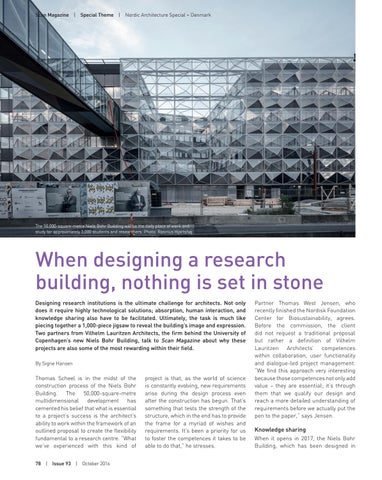Scan Magazine | Special Theme | Nordic Architecture Special – Denmark
The 50,000-square-metre Niels Bohr Building will be the daily place of work and study for approximately 3,000 students and researchers. Photo: Rasmus Hjortshøj
When designing a research building, nothing is set in stone Designing research institutions is the ultimate challenge for architects. Not only does it require highly technological solutions; absorption, human interaction, and knowledge sharing also have to be facilitated. Ultimately, the task is much like piecing together a 1,000-piece jigsaw to reveal the building’s image and expression. Two partners from Vilhelm Lauritzen Architects, the firm behind the University of Copenhagen’s new Niels Bohr Building, talk to Scan Magazine about why these projects are also some of the most rewarding within their field. By Signe Hansen
Thomas Scheel is in the midst of the construction process of the Niels Bohr Building. The 50,000-square-metre multidimensional development has cemented his belief that what is essential to a project’s success is the architect’s ability to work within the framework of an outlined proposal to create the flexibility fundamental to a research centre. “What we’ve experienced with this kind of 78 | Issue 93 | October 2016
project is that, as the world of science is constantly evolving, new requirements arise during the design process even after the construction has begun. That’s something that tests the strength of the structure, which in the end has to provide the frame for a myriad of wishes and requirements. It’s been a priority for us to foster the competences it takes to be able to do that,” he stresses.
Partner Thomas West Jensen, who recently finished the Nordisk Foundation Center for Biosustainability, agrees. Before the commission, the client did not request a traditional proposal but rather a definition of Vilhelm Lauritzen Architects’ competences within collaboration, user functionality and dialogue-led project management. “We find this approach very interesting because those competences not only add value – they are essential; it’s through them that we qualify our design and reach a more detailed understanding of requirements before we actually put the pen to the paper,” says Jensen.
Knowledge sharing When it opens in 2017, the Niels Bohr Building, which has been designed in
